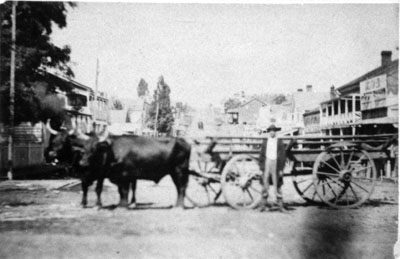
It began with the Kennedy family settling in the area around 1823. George Kennedy took up 200 acres of land and built a mill on what is now Mill Street. A sawmill and foundry were also added over time. As many settlers from all over Esquesing had to travel quite far to use the mill, the Kennedy home was always open and welcoming. For the first several years, only a few families lived in the area, including the Stulls and the Williams. The settlement was named Hungry Hollow, a reflection of the rough beginning these early families had.
Hope for the community appeared in 1837 when the Barber brothers purchased the mill from George Kennedy. When the Barbers moved their business to Streetsville, the mill was temporarily run by David Forbes. The Barbers eventually took it back over. The mill helped encourage more settlement and business in the area, with the first store opening in 1840.

In 1853 the Grand Trunk Railway was built through Georgetown. This encouraged even more traffic, business and settlement. By 1877, the population was 1,500.
Unfortunately, there was an agricultural depression in the 1890s. The town regressed before returning to prosperity by 1922 with new industries developing. Smith & Stone began manufacturing in 1919 and Dominion Seed House began mailing out its world-famous seeds in 1927, among many others. The paper business also flourished, earning Georgetown a new nickname: Papertown.

The 1950s brought a new surge of development when businessman Rex Heslop began to buy farms between Georgetown and Norval in 1954. As Heslop developed the farms into homes, Georgetown’s area doubled, and the population grew. In the beginning, mainly British descendants lived in Georgetown. But the mid-1900s saw people of all backgrounds beginning to settle in the community.
In 1923 and 1924, Georgetown welcomed the “Georgetown Boys,” a group of over 100 Armenian orphans to Cedar Vale Farm. This was Canada’s first international humanitarian act. In 1947, Therese St. Jean operated a farm school for orphaned boys from Quebec. The farm school and St. Jean are often credited with establishing a francophone community in Georgetown.
All over Georgetown, buildings, plaques and even parks pay homage to the many historical businesses and people that have made it into the vibrant community it is today.
A Family Affair
Although George Kennedy is the most notable member of the founding family of Georgetown, settling the area was a family affair.
John Kennedy and his first wife, Charity, moved with their children to Canada after the American Revolution. Like many United Empire Loyalists, they first settled in the Niagara area in 1795. Their children were John, Elizabeth, Ann, Charles, Morris, Samuel and George.
Around 1819, Charles Kennedy, hired by Abraham Nelles, began to survey Esquesing lots. This was the earliest connection between the Kennedy family and the area. The Kennedy siblings and their respective families began to settle the area around 1823.
George, along with his wife Sarah, dammed up Silver Creek to build a mill. Their daughter Harriet is often said to have been the first settler child to be born in Esquesing.
Morris Kennedy went on to establish the first church in Georgetown.
Charles Kennedy was influential in local politics and was one of the first two wardens. Charles married Elizabeth Williams, the daughter of Glen Williams’ founder Benajah Williams. Elizabeth Kennedy, Charles’ sister, also eventually became Benajah Williams’ third wife.

